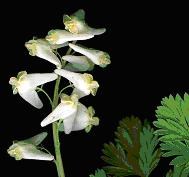
Photograph by: Michael Clayton Kingdom: Plantae - Plants Division: Magnoliophyta – Flowering plants Class: Magnoliopsida - Dicotyledons Family: Fumariaceae – Fumitory family Genus:Dicentra Bernh. – bleeding heart Life Cycle: Perennial Description: Habitat: It grows in rich woods and on rocky slopes, up to 5,200 feet in elevation (Stukham, 2001). They are found on North to Northeastern slopes. In Shenandoah National Park, it can be found in lower to middle elevations, on Northern slopes, East of Skyline Drive. They have been seen in areas such as White Oak, and Upper Dark Hollow Falls. Many can be found near trout lily, and spring beauty (Interview: Mara Meisel, 2005). Common Names: Soldier cap, white hearts, eardrops, monks head, butterfly banners, kitten breeches, bachelors breeches, little boys breeches, and staggerweed (Wisconsin Cooperative Educational Service Agency, Toxic Plant Database, Veterinary Medicine, Perdue University). Other Facts: The plant contains several isoquinoline alkaloids, including aporphine and protopine (found in opium poppies), all of which are poisonous (Adkins, 2005). These alkaloid are a central nervous system (CNS) depressant, which can cause paralysis and tremors. Eating the leaves and roots can cause poisoning, similar to bleeding heart. The symptoms include a staggering gait or walk, which gives it one of its common names (staggerweed). Cattle and horse feed on this plant during spring grazing, causing sudden trembling which increase in severity, frothing of the mouth, ejection of partially digested stomach contents, and convulsions. (University of Illinois – Urbana, Veterinary Medicine Toxic Plant website, 2005). The Iroquois used leaf ointment to create more limber legs on athletes. Leaf poultice is used for skin ailments, and the root turned into a tea becomes a diuretic, which promotes sweating (Foster, Steven, & Duke, 1977). References and Links Foster, Steven, James Duke 1977. Petersons Field Guide, Eastern/Central Medicinal Plants. Houghton Mifflin Company, Boston. Pp. 12-13 Stupka, Arthur 1965. Wildflowers in Color. Harper & Row Publishers, New York. Pg. 40 Grimm, William C. 1993. The Illustrated Book of Wildflowers and Shrubs. Stackpole Books Publishers, Harrisburg, PA. Pp. 112-113 Steere, William C., Harold W. Rickett 1965. Wildflowers of the United States, VI (The Northeastern States). McGraw-Hill Book Company, New York. Pg. 182 Adkins, Leonard 2005. Wildflowers of the Blue Ridge and Great Smokey Mountains. Menasha Ridge Press, Birmingham, AL. Pp. 18-19 Thieret, John, William Niering, Nancy Olmstead 2001. National Audubon Society: Field Guide To Wildflower – Eastern Region. Chanticleer Press. Pp. 552-553 Interview: Mara Miesel, National Park Service Interpretive Ranger, conducted May 2005 Further information about Dutchman’s Breeches can be found in: Integrated Taxonomic Information System (ITIS) Report Germplasm Resource Information Network database which is sponsored by the Agricultural Research Service, U.S. Department of Agriculture. PLANTS National Database, a website supported by the Natural Resource Conservation Service.
|
Last updated: February 26, 2015
